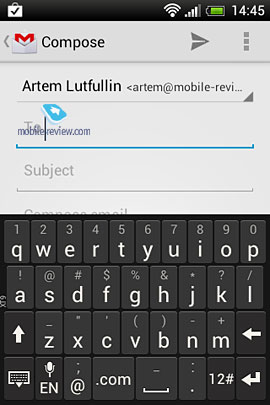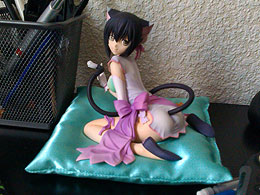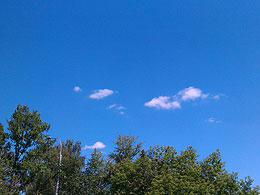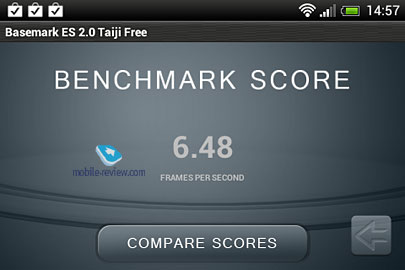|
|
HTC Desire C Review
Live photos of HTC Desire C
Contents:
- In the box
- Positioning
- Design & materials
- Build quality
- Dimensions
- Controls
- Screen
- Camera
- Battery life
- Performance
- Connectivity
- Navigation
- Software
- Sound
- Conclusion
In the box:
- Handset
- Charger
- USB-microUSB cable
- Wired stereo earphones with music and phone call control buttons
Back to the table of contents >>>
Positioning
HTC happened to have never had good sales in the low-end sector, although they have made a series of repeated attempts to consolidate some position in this very sector. Every year they produce new inexpensive handsets, while in 2010 they even surprised us with their decision to enter the market for low-end solutions with a touchphone running their proprietary system.
But the reasons for failure were the same every time: a small manufacturer can't afford to release two or even 4 or 5 low-end models at once, which is sometimes done by Samsung or LG. Besides, HTC is traditionally considered a company that sells high-end smartphones, so the high prices they got used to have always been affecting the low-end sector as well. To put it simply, the low-end models by HTC were always offered at higher prices that the handsets with similar specs by other manufacturers.

HTC Smart was their first and last attempt to enter the market for low-end solutions with a touchphone
In early 2011, the company decided to change their strategy and introduced the Wildfire S smartphone for the low-end sector. In its design, the handset resembled HTC's flagship of that period, but it actually was at the middle-end level with its technical specifications. Probably, that handset could be a success in some local markets, but in Russia there already were a few more interesting middle-end devices at the time when they started selling it. Some of those devices had already spent some time on the shelves by the moment, and so their prices started going down Ц we may think of LG Optimus One, for instance.

The HTC Wildfire S was quite interesting for those days, but it ran up against some cheaper handsets offered by the competitors, LG and Samsung
Hence, the company is still searching for a solution that could make the HTC brand successful in the market for low-end handsets. As never before, they now need a successful product in the low-end or middle-end segment, as this year they are really far from being alone in the top segment that has traditionally been their strong point.
So, here's another attempt to reach out to the customers in the low-end segment, or just to enhance the lineup, if they have finally given up the idea of consolidating some position here Ц the HTC Desire C. I'd call it a high-sounding name, even though it has the 'C' index. Right from the start, its attractive design and the adequate pricetag should make the Desire C the very smartphone that will help the company in the market for low-end handsets. Will it go that way?
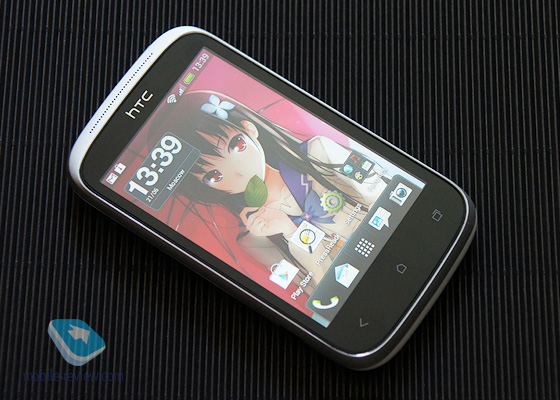
Back to the table of contents >>>
Design & materials
The design of this model resembles that of the more expensive ones. If you don't put the handsets side by side when their dimensions become recognizable, you can easily mistake the turned off HTC Desire C for a One S or One X:
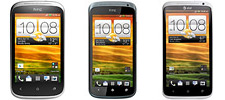
There are three colors available for this handset: bright red, black, and white. I had a white one for this review. The battery cover in this version is made of smooth plastic that resembles a lot, with its characteristics, the material used in the white HTC One X. In the red and black versions the plastic is of the same kind. The frame around the screen is made of metal; the screen is protected with glass. I wasn't able to produce any scratches on it, applying some not too strong efforts with scissors or knife. But I guess the glass will certainly get covered with hardly noticeable small scratches after some time though.


I liked the appearance of this smartphone. It doesn't look too simple. The handset body has no glossy plastic or various sorts of "shining" elements that has set our teeth on edge in low-end Korean devices Ц everything is quite ascetic, but simple and good-looking though. If I were choosing an inexpensive smartphone, looking at its design only, I would be definitely considering the HTC Desire C among the first things to think about. Too bad it's not only the design that makes the handset.
The back cover in the white handset gets soiled very easily. I don't know how it is with the other colors though. If you carry this handset in a pocket together with some coins, or in a rucksack, its cover will look like this every time you take it out:


The cover surface gets soiled very fast, and you have to clean it all the time if you don't want your handset to look a little dirty. Probably, it's not a critical issue in the end, as glossy devices are always covered with some stains, too, but I guess I just had to mention it.
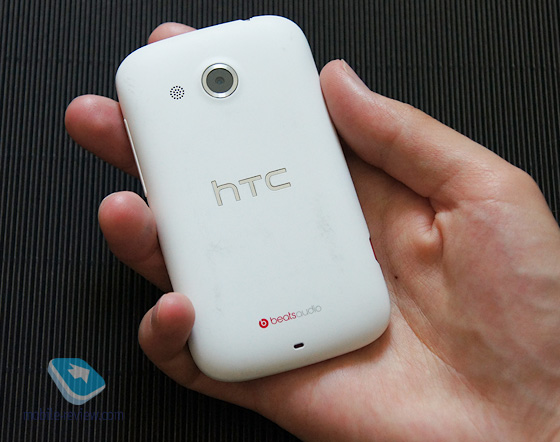
The glass protecting the screen also gets smudged all the time and the smudges are very well visible, so you have to clean it, too.

By the way, the inner part of the handset body is made of red plastic no matter what color is the exterior, which looks quite interesting.
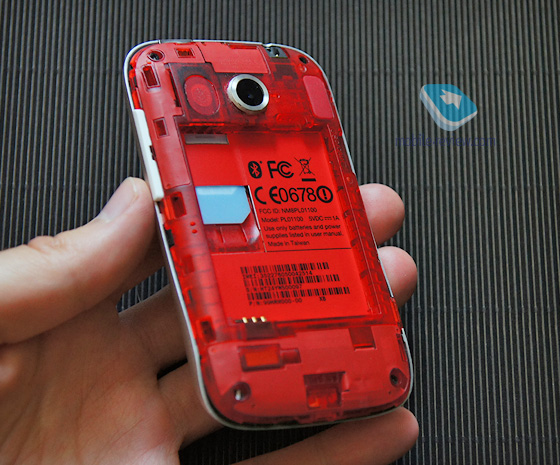
Back to the table of contents >>>
Build quality
Almost no complaints about the build quality. In my sample, the battery cover had some clearance of about 0.5 mm at the points where it is attached to the rest of the body, but I don't think it's a serious drawback. In all the rest, nothing produces any creaks or has any free play between the elements, so the handset really feels as a well-assembled device in your hand.

Back to the table of contents >>>
Dimensions
The smartphone is quite compact. As this is a low-end device, we should first look at it in comparison to other inexpensive touchphones:
- HTC Desire C Ц 107.2 x 60.6 x 12.3 mm, 100 g
- HTC Wildfire S Ц 101 x 59 x 12 mm, 108 g
- Apple iPhone 4S Ц 115.2 x 58.6 x 9.3 mm, 140 g





The Desire C fits perfectly in the hand; it's comfortable to use it as a phone, as well as to hold the device and handle its menu with a single hand.
Back to the table of contents >>>
Controls
The smartphone runs Android 4.0, so all the controls are made in accordance with the requirements of the operating system. This means that, the same way like in the flagship models, we don't have those usual four buttons under the screen, including the search key, but now there are only three standard buttons, from left to right: Back, Home and Recent Apps Menu.

The touch buttons are quite distanced from each other, while their marks are simple and clear. The buttons don't have any illumination Ц probably, the manufacturer decided to save some cost on it. I can't say that it's too uncomfortable for me to use a smartphone without the keys illuminations, but some people will certainly find a smartphone with this illumination much more comfortable to use than a device without it. So I think it's a strange decision by HTC.

Every time you touch the buttons, the handset produces a hardly noticeable vibration. It's a bit stronger in other HTC devices, but here you can hardly feel it. Like in the handsets of the One Series, the context menu button is replaced with the Recent Apps key, which is doubtfully helpful. The search button, traditional for HTC, doesn't exist anymore either. But, on the other hand, in the Desire C the manufacturer has solved another issue that is characteristic for Android 4.0 devices. The fact is that a lot of applications from the store, which have not been optimized for the new OS yet, are now displayed with a black stripe occupying quite a lot of the screen space and representing the on-screen context menu button. But the HTC Desire C doesn't have that stripe, and all you have to do to make the context menu show up is hold the Recent Apps button for a couple of seconds. I can't say it's quite comfortable, but it's surely better than the black stripe occupying 10% of the usable screen space.
But we may regret that the other two buttons don't provide two different actions as before, when tapped or held.
And a few words about the other control elements. The right side of the smartphone accommodates the volume control button. It's not easy to use it without looking at it, as it's very thin. On the left part of the bottom, we have a microUSB jack; on the top there are the power button and a 3.5-mm audio jack. Holding the power button launches a menu that allows turning the handset off, switching to the flight mode, or rebooting the device.


At the top of the front side, we find the voice speaker; the light and proximity sensors are nearby. The backside features the eyelet of a 5-megapixel camera, a nicely designed grid of the ringing speaker. At the bottom, we see the Beats Audio logoЕ We'll talk about its influence on the customers' minds and the sound quality hereunder.


The smartphone has no indicators.
The memory card slot is located under the battery cover, while the SIM card slot is under the battery itself.

Back to the table of contents >>>
Screen
The HTC Desire C features a touch sensitive capacitive TFT screen with a 3.5-inch diagonal and HVGA resolution (320 x 480 pixels). Their previous low-end model, the HTC Explorer, and even its predecessor, the HT— Wildfire S, also had screens with almost identical specifications. The physical dimensions of the screen are 73 x 49 mm; it's capable of rendering up to 16 million colors and sports a good brightness reserve and the automatic brightness level adjustment function.

The screen ensures maximum viewing angles, so the image doesn't get distorted even at maximum inclination. The colors are not bad, but the image isn't as sappy as it could be. However, it would be naive to expect something more from a screen of this kind. Under open sunlight, the image fades completely and it becomes almost impossible to see anything.



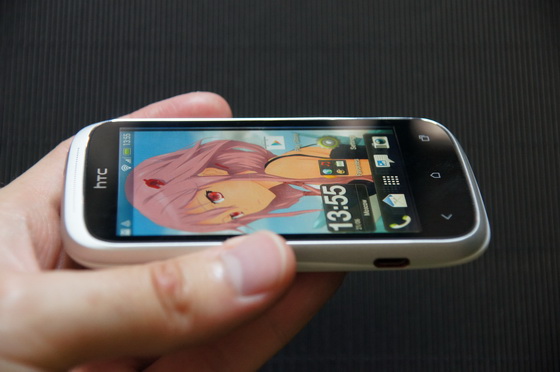
The screen supports 4 touches at a time. In general, it responds to the touches quite well, but you may sometimes encounter some problems though. For example, you may have to tap three or four times on the same checkbox to make the mark appear.

Typing is surprisingly comfortable. I thought that after using the big high-end smartphones I wouldn't be able to write text messages on the HTC Desire C at all, but it turned out quite different: the keyboard is convenient, with pretty big buttons, and typing is easy. It takes a little time to get used to it, but no more than a day normally.

Generally, the screen is certainly one of the weakest points of this handset. It's small, with low resolution, and totally unreadable under open sunlight.
Back to the table of contents >>>
Camera
The smartphone has a very simple 5-megapixel camera with fixed focus. I'd like to allow myself to omit any detailed description of its capabilities, as they are really minimal. And the picture quality it produces makes it particularly senseless to delve into the settings trying to improve it.

The maximum picture resolution is 2,592 x 1,728 pixels (with the widescreen mode turned on), but you can also switch to the 4:3 side ratio. There are dedicated settings for white balance, ISO, exposure, and saturation. You can apply special effects to your pictures.
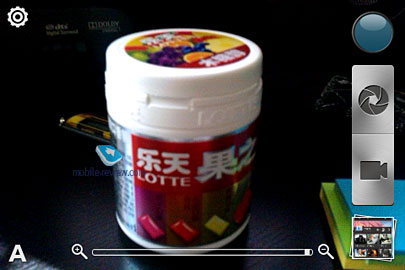

The maximum resolution available for video recording is 640 x 480 pixels. Effects are also available for video, and so are the settings for white balance, exposure, contrast, saturation, and sharpness. The picture remains zoomable when shooting a video.
You can judge about the quality of pictures and videos by the samples below.
Zoom:
Back to the table of contents >>>
Battery life
The HTC Desire C uses a 1,230-mAh Li-Ion battery. My handset was able to stay alive for about a day when I listened to some music for 3 or 4 hours daily and used it practically in the same way like the One Series smartphones before: an hour of talking, 10 to 20 text messages, a GMail account with push-mail on, and about an hour of web surfing.

The battery life seems quite good, especially if you look at the flagship model with its 5 or 6 hours only. However, if we remember we are talking about a low-end handset here, it may seem that it doesn't work so long. I believe even a low-end Android handset should be able to work at least for a day or a day and a half.
Back to the table of contents >>>
Performance
The smartphone is built on the Qualcomm MSM7225A platform and has a 600-MHz CPU. The previous HTC's low-end model, the HTC Explorer, also had a similar platform, as well as a lot of other low-end handsets by other manufacturers: LG Optimus L3, Sony Xperia Tipo, ZTE Skate. The handset has 512 MB of RAM and 4 GB of internal storage. Besides, there is a microSD card slot. Before speaking about the smartphone performance, I suggest we should look at some benchmark results:
When performing the most ordinary tasks, such as opening a menu, launching the email application or opening the contact list, you may often notice some lags in the smartphone operation. Moreover, working with the HTC Desire C, one should right away get used to a second's delay between a tap and the handset's response to the tap.
I won't describe the capabilities of this smartphone in video playback, as it is senseless to watch high quality videos on such a small screen, but anyway I can say the performance provided by the HTC Desire C is very poor. A couple of years ago we could excuse such lags and delays in a low-end handset, but the times have changed and users have already got accustomed to more or less smooth operation of at least the main interface in any smartphone. But here those lags and delays appear directly in the routine operations with the ordinary applications, such as web browser, phone, etc.

Back to the table of contents >>>
Connectivity
The smartphone operates in the GSM (850/900/1800/1900) and UMTS (900/2100) networks and supports the two high-speed data transmission standards: EDGE and HSDPA. You can turn the connection modules on and off using the menu settings or one of the tabs on the system panel falling down from the top of the screen, or through the widgets. There is a special widget presenting a line of icons for controlling the connections, as well as individual widgets and the standard Android one.

To synchronize the handset with a PC and for data transfer you have to use the bundled microUSB cable. The USB interface is 2.0. When connected to a computer, there appears a menu where you can select one of the five connection options: charging only, Drive (the internal memory is visible), HTC Sync, Modem (for using the handset as a modem for internet access), and connection to a PC providing access to the Internet from the handset via the computer.
The handset features an in-built Bluetooth 4.0 module supporting A2DP and EDR, as well as all other major profiles.
Wi-Fi (802.11а/b/g/n). There are no complaints about the operation of the Wi-Fi module. The settings allow adjusting the rules of switching to sleep mode, using a static IP only, and adding security certificates. There is also a special mode for the maximum performance of the Wi-Fi connection. With Wi-Fi on, the handset practically doesn't get warm.
Wi-Fi router. The HTC Desire C has a feature of sharing 2G/3G internet connection via Wi-Fi. It works as follows. You go to the wireless connections menu and enable the Wi-Fi Router option, which opens the settings menu. Then you select the network name, password and connection type (WEP, WPA, WPA2). Besides, you can set the maximum number of allowed connections to your handset, or you can allow or ban every new connection individually.
NFC. As an option for the HTC Desire C, the manufacturer claims NFC support, but I didn't have it my handset.
Back to the table of contents >>>
Navigation
The smartphone has a gpsOne chip built on the Qualcomm platform. It takes about 10 to 15 seconds to establish connection with the satellites. For the navigation the handset uses the standard Google applications only: Google Maps and Google Navigation. The application based on Route 66 offered in the more expensive smartphones by HTC is not available here. Google Maps allow building routes and finding addresses by street or location names. Google Navigation provides route tracking and voice hints.
Back to the table of contents >>>
Software
The smartphone runs Android 4.0.3 and features the HTC Sense 4.0 interface extension. The interface looks the same as in the more expensive models, but still some functions are curtailed. For example, some of the widgets available in the One Series handsets are absent. Besides, you can't call the matrix of the desktops to quickly switch between them. The weather application doesn't have HTC's usual animation. There may also be some other missing features that I haven't noticed.
The Recent Apps button calls up mini icons representing fragments of the recently launched applications. The fragments are not screenshots of those apps, so this apps management mode resembles the one used in the tablet version of Android 3.0.

The set of available applications is standard for HTC: news reader, Adobe Reader, Facebook, trial version of Polaris Office, and a free version of SoundHound. And here, a few more words about the sound.
Back to the table of contents >>>
Sound
Normally I try not to hold forth on the sound quality, as this has never been a strong point of mine. But the presence of the Beats Audio nameplate on the body of the inexpensive HTC Desire C prompted me to compare the sound quality provided by this handset with that of the HTC One S that was at hand at the time, while my HTC One X had been given for a while to Evgeny Vildyaev, so that could write this cheerful article:
I've tested the sound quality provided by the HTC Desire C by using a Chinese earphone set, the Awei es900i, bought in Hong Kong at some 150-200 rubles, if I'm not mistaken. Some people tried to convince me that these earphones produce quite a good sound quality and that, judging by our own yardsticks, they sound like the ones that might as well cost a couple of grands. Upon coming back home, I gave them to some friends of mine, and they all admitted the sound quality was quite good. But let's return to the sound produced by this low-end HTC handset.

With the Beats Audio effect turned off, the sound produced by the HTC Desire C is clear but flat and inexpressive to some extent. As for the HTC One S, I liked its sound far better, also with the improvers turned off: the sound is much deeper and has more volume, if I can use such a description. When the Beats Audio is on, the sound became slightly different, but I can't say if it's better or worse. Hence, the general thought I'm trying to express is that the One S sounds better than the Desire C, regardless of the fact that the Beats Audio logo is present on both handsets. Even with my ears, so bad for music, I could notice the difference. So you can imagine how great that difference would be for a more fastidious listener.
Back to the table of contents >>>
Conclusion
There are no complaints about the reception quality and the voice rendering quality. My handset showed really well in receiving the network signal during the entire two-week period I had been using it. The voice speaker of the HTC Desire C is not bad, and you can hear the one you are talking with quite well, with the voices being clear and without any noise. The volume is a bit above moderate. The ringing speaker is of moderate quality if compared to more expensive smartphones and is too weak if compared to other low-end models. I got used to the fact that low-end handsets usually produce very loud sounds, with a poor quality though. But here, it seems the manufacturer decided not to sacrifice the sound quality. As a result, even at maximum volume you can hardly hear the phone ringing when, for instance, walking along a pretty quiet street. The vibration alert is also moderate.

This smartphone is already available at 8,990 rubles. If you try, you may find it at a little lower price of about 8,500 rubles. As far as I can judge, the HTC Desire C has only two serious advantages, one of them being quite subjective though. First, the Sense interface makes the phone comfortable to use out of the box, so this handset is perfect for using as a phone only. Second, its design makes it stand out against the background of a lot of plain and monotonous low-end handsets. But there come the drawbacks then: obsolete screen with low resolution, low-performance platform resulting in delays and lags in the smartphone operation, the curtailed Sense version, more than a moderate battery life, and the camera Ц even worse than that of the 18-month-old HTC Wildfire S where it was possible at least to take pictures of texts or close-ups.
And, no matter how strange it may sound, the major disadvantage of this handset is its price. Paying only 7,000 rubles, you can purchase the HTC Wildfire S which is better than this one in every aspect. Or you can pay 6,000 rubles and get the HTC Explorer which is as simple as the Desire C. But with the prices being lower, both the Wildfire S and the Explorer run older Android versions, but without any lags though.
When after that unsuccessful attempt to enter the market for low-end models with the HTC Smart touchphone, the company introduced the Wildfire S, they seemed to have finally found the key to success. The approach seemed quite interesting and was probably the right one, but requiring some improvement though. But later, there came the weird HTC Explorer, which meant the company had got back to producing their low-end models just on leftovers. Unfortunately, the HTC Desire C is of that sort too: the handset sports a nice design and good-quality interface, but nothing else. So it's not clear at all what it can attract customers' attention with.
Specifications:
- Type: smartphone
- Form factor: candybar
- Materials: matt plastic, metallic frame
- Operating system: Android 4.0.3, proprietary HTC Sense 4.0 interface
- Network: GSM/EDGE 850/900/1800/1900 MHz, UMTS/HSDPA 900/2100
- CPU: 600 MHz, Qualcomm MSM7225A platform
- RAM: 512 MB
- Memory: 4 GB, microSD card slot
- Connectivity: Wi-Fi (a/b/g/n/), Bluetooth 4.0 (A2DP), microUSB (USB 2.0) for charging and synchronizing, 3.5-mm audio jack
- Screen: capacitive, TFT, 3,5", 320 x 480 pixels (HVGA), automatic brightness level
- Camera: 5 MP, fixed focus, VGA (640 x 480 pixels) video recording
- Navigation: GPS, Qualcomm platform gpsOne chip (A-GPS support)
- Miscellaneous: accelerometer, light sensor, proximity sensor, FM radio
- Battery: removable, Li-Ion, 1230 mAh
- Dimensions: 107.2 x 60.6 x 12.3 mm
- Weight: 100 g
Back to the table of contents >>>
Artem Lutfullin (artem@mobile-review.com)
 Twitter Twitter
Translated by Serge Gomelsky (s_gomelsky@mail.ru)
Published — 03 July 2012
Have something to add?! Write us... eldar@mobile-review.com
|
News:
[ 31-07 16:21 ]Sir Jony Ive: Apple Isn't In It For The Money
[ 31-07 13:34 ]Video: Nokia Designer Interviews
[ 31-07 13:10 ]RIM To Layoff 3,000 More Employees
[ 30-07 20:59 ]Video: iPhone 5 Housing Shown Off
[ 30-07 19:12 ]Android Fortunes Decline In U.S.
[ 25-07 16:18 ]Why Apple Is Suing Samsung?
[ 25-07 15:53 ]A Few Choice Quotes About Apple ... By Samsung
[ 23-07 20:25 ]Russian iOS Hacker Calls It A Day
[ 23-07 17:40 ]Video: It's Still Not Out, But Galaxy Note 10.1 Gets An Ad
[ 19-07 19:10 ]Another Loss For Nokia: $1 Billion Down In Q2
[ 19-07 17:22 ]British Judge Orders Apple To Run Ads Saying Samsung Did Not Copy Them
[ 19-07 16:57 ]iPhone 5 To Feature Nano-SIM Cards
[ 18-07 14:20 ]What The iPad Could Have Looked Like ...
[ 18-07 13:25 ]App Store Hack Is Still Going Strong Despite Apple's Best Efforts
[ 13-07 12:34 ]Infographic: The (Hypothetical) Sale Of RIM
[ 13-07 11:10 ]Video: iPhone Hacker Makes In-App Purchases Free
[ 12-07 19:50 ]iPhone 5 Images Leak Again
[ 12-07 17:51 ]Android Takes 50%+ Of U.S. And Europe
[ 11-07 16:02 ]Apple Involved In 60% Of Patent Suits
[ 11-07 13:14 ]Video: Kindle Fire Gets A Jelly Bean
Subscribe
|



































